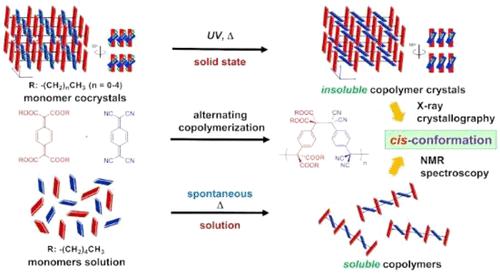当前位置:
X-MOL 学术
›
Macromolecules
›
论文详情
Our official English website, www.x-mol.net, welcomes your feedback! (Note: you will need to create a separate account there.)
Preservation of the Conformational Structures of Single-Polymer Crystals in Solution
Macromolecules ( IF 5.5 ) Pub Date : 2022-06-22 , DOI: 10.1021/acs.macromol.2c00437 Takahito Itoh 1 , Tatsuya Suzuki 1 , Fumiaki Kondo 1 , Takumi Suzuki 1 , Takahiro Uno 1 , Masataka Kubo 1 , Norimitsu Tohnai 2 , Fumio Sanda 3 , Mikiji Miyata 4
Macromolecules ( IF 5.5 ) Pub Date : 2022-06-22 , DOI: 10.1021/acs.macromol.2c00437 Takahito Itoh 1 , Tatsuya Suzuki 1 , Fumiaki Kondo 1 , Takumi Suzuki 1 , Takahiro Uno 1 , Masataka Kubo 1 , Norimitsu Tohnai 2 , Fumio Sanda 3 , Mikiji Miyata 4
Affiliation

|
We have found that the cis-conformational structures in single-polymer crystals obtained by solid-state polymerization are retained in solution. A soluble alternating copolymer was accidentally obtained during our research employing a series of 7,7,8,8-tetrakis(alkoxycarbonyl)-p-quinodimethanes (1) with alkoxy groups such as methoxy(1a(Me)), ethoxy(1b(Et)), propoxy(1c(Pr)), isopropoxy(1d(iPr)), butoxy(1e(Bu)), isobutoxy(1f(iBu)), pentyloxy(1g(Pen)), hexyloxy(1h(Hex)), and dodecyloxy(1i(Dod)). Thus, 1a(Me), 1b(Et), 1c(Pr), 1e(Bu), and 1g(Pen) with linear alkoxy groups afforded 1:1 charge-transfer complex crystals with 7,7,8,8-tetracyanoquinodimethane (3), while 1d(iPr), 1f(iBu), 1h(Hex), and 1i(Dod) with branching or linear long-chain alkoxy groups did not. The former crystals topochemically underwent photochemical and thermal copolymerizations via a radical mechanism to yield cis-conformational alternating copolymer crystals according to X-ray crystallography. Attractively, the rates of thermal copolymerization were found to increase roughly with an increase in the chain length of the linear alkoxy groups and/or a decrease in the reacting exomethylene carbon distances between 1 and 3. This finding led us to carry out a spontaneous copolymerization of 1g(Pen) with 3 in solution, resulting in the first synthesis of a soluble alternating copolymer during our research. Spectral analyses of the soluble copolymer of 1g(Pen) with 3, together with geometry optimization and spectroscopic simulations, proved that the cis-conformational structure was retained in solution as well as in the solid state. This provides the first spectral observation of a cis-conformational structure in solution with respect to the alternating copolymers of the p-quinodimethane derivatives.
中文翻译:

在溶液中保持单聚合物晶体的构象结构
我们发现通过固态聚合获得的单聚合物晶体中的顺式构象结构保留在溶液中。在我们的研究中偶然获得了一种可溶性交替共聚物,该共聚物采用一系列具有甲氧基(1a(Me))、乙氧基(1b )等烷氧基的 7,7,8,8-四(烷氧基羰基)-对-醌二甲烷(1 )。 Et))、丙氧基( 1c (Pr))、异丙氧基( 1d (iPr))、丁氧基( 1e (Bu))、异丁氧基( 1f (iBu))、戊氧基( 1g (Pen))、己氧基( 1h (Hex) ) 和十二烷氧基( 1i (Dod))。因此,1a(我),1b具有直链烷氧基的(Et)、1c (Pr)、1e (Bu) 和1g (Pen) 与 7,7,8,8-四氰基醌二甲烷 ( 3 ) 形成 1:1 电荷转移络合物晶体,而1d (iPr )、1f (iBu)、1h (Hex) 和1i(Dod) 没有支链或直链长链烷氧基。根据 X 射线晶体学,前一种晶体通过自由基机理在拓扑化学上进行光化学和热共聚,产生顺式构象交替共聚物晶体。有吸引力的是,发现热共聚速率随着线性烷氧基链长度的增加和/或反应的外亚甲基碳距离在1和3之间的减少而大致增加。这一发现使我们在溶液中进行了1g (Pen) 与3的自发共聚,从而在我们的研究中首次合成了可溶性交替共聚物。可溶性共聚物的光谱分析1g (Pen) 和3以及几何优化和光谱模拟证明了顺式构象结构在溶液和固态中都保留了下来。这提供了溶液中顺式构象结构相对于对-醌二甲烷衍生物的交替共聚物的第一次光谱观察。
更新日期:2022-06-22
中文翻译:

在溶液中保持单聚合物晶体的构象结构
我们发现通过固态聚合获得的单聚合物晶体中的顺式构象结构保留在溶液中。在我们的研究中偶然获得了一种可溶性交替共聚物,该共聚物采用一系列具有甲氧基(1a(Me))、乙氧基(1b )等烷氧基的 7,7,8,8-四(烷氧基羰基)-对-醌二甲烷(1 )。 Et))、丙氧基( 1c (Pr))、异丙氧基( 1d (iPr))、丁氧基( 1e (Bu))、异丁氧基( 1f (iBu))、戊氧基( 1g (Pen))、己氧基( 1h (Hex) ) 和十二烷氧基( 1i (Dod))。因此,1a(我),1b具有直链烷氧基的(Et)、1c (Pr)、1e (Bu) 和1g (Pen) 与 7,7,8,8-四氰基醌二甲烷 ( 3 ) 形成 1:1 电荷转移络合物晶体,而1d (iPr )、1f (iBu)、1h (Hex) 和1i(Dod) 没有支链或直链长链烷氧基。根据 X 射线晶体学,前一种晶体通过自由基机理在拓扑化学上进行光化学和热共聚,产生顺式构象交替共聚物晶体。有吸引力的是,发现热共聚速率随着线性烷氧基链长度的增加和/或反应的外亚甲基碳距离在1和3之间的减少而大致增加。这一发现使我们在溶液中进行了1g (Pen) 与3的自发共聚,从而在我们的研究中首次合成了可溶性交替共聚物。可溶性共聚物的光谱分析1g (Pen) 和3以及几何优化和光谱模拟证明了顺式构象结构在溶液和固态中都保留了下来。这提供了溶液中顺式构象结构相对于对-醌二甲烷衍生物的交替共聚物的第一次光谱观察。



























 京公网安备 11010802027423号
京公网安备 11010802027423号